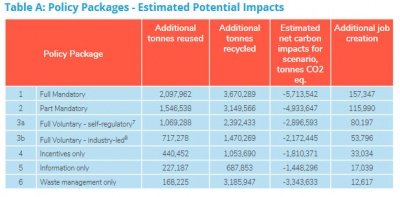Cutting furniture waste could create up to 157k new jobs in EU
Implementing circular economy principles into the EU’s furniture industry through refurbishment and remanufacture could create up to 157,000 jobs and save around six million tonnes of CO2, according to a new report by the European Environmental Bureau (EEB).
The new study, published today (26 September) by the EEB, a European network of environmental organisations with 140 members in over 30 countries, and compiled by Eunomia Research & Consultancy, presents and explores a range of policy options designed to improve waste prevention and resource management in the European furniture sector.
It states that doing so would facilitate value recovery, economic growth and job creation as well as combat environmental degradation and promote resource efficiency.
 Every year, 10.5 million tonnes of furniture are consumed by the EU market, most of which is produced by SMEs, with a corresponding 10 million tonnes thrown out over the same period of time, most of which, the report says, end up in landfill or incineration once they have been discarded by businesses or individual consumers.
Every year, 10.5 million tonnes of furniture are consumed by the EU market, most of which is produced by SMEs, with a corresponding 10 million tonnes thrown out over the same period of time, most of which, the report says, end up in landfill or incineration once they have been discarded by businesses or individual consumers.
This issue is not helped by challenges faced by the European furniture sector, namely the rising cost of materials, the poor turnover in its workforce and the growing competitiveness of low-cost countries such as China.
The EEB says, however, that increased refurbishment and remanufacture of furniture allows for resources to be kept within the economy, retaining a productive value for as long as the product is kept within the resource loop.
Such practices are currently hampered by the lower quality of materials available making reuse more difficult, poor consumer information on how to repair furniture, limited collection and take-back infrastructure, the high cost of repair and refurbishment, poor demand for second-hand furniture and recycled materials, and weak over-arching policy drivers.
Among the most effective measures recommended in the report to reduce furniture waste are:
-
Stricter criteria for ecodesign, including restrictions on the use of chemicals to facilitate reuse, repair and recycling;
-
Better business models to cut furniture waste;
-
Incentives to take back discarded furniture and mandatory producer responsibility schemes; and
-
Life-cycle impact information for procurers, repairers and recyclers as well as consumers.
Commenting on the release of the report, Carsten Wachholz, Senior Policy Officer for Product Policy at the EEB, said: “By avoiding furniture waste, EU policy makers can boost a market that was hardly hit by the recent crises and is part of our cultural heritage and style. But this will require the adoption of appropriate demand and supply chain levers to support a change across the industry“.
Alex Forrest, Senior Consultant at Eunomia, added: “This report presents a compelling economic, social and environmental case for transitioning towards a more circular European furniture sector. Forward thinking brands are already thinking along these lines. We hope that the policy options and impacts highlighted in this study positively contribute towards development of wider circular activity across this important sector.”
Getting down to policy
The report’s headline figures of 157,000 potential jobs created and six million tonnes of CO2 emissions saved are based on analysis contributing to six potential policy packages detailed in the study.
Each policy package is formed of a number of policy proposals which cohere within a particular policy approach. Package One takes a fully mandatory approach to increasing furniture refurbishment and remanufacture, with a proposed mandatory extended producer reponsibility (EPR) scheme for furniture take-back or an individual producer responsibility (IPR) approach to encourage better design with repair and recycling in mind.

Package Two, meanwhile, takes a part-mandatory approach, proposing a mandatory EPR system with a modulated fee based on a ‘Green Furniture Mark’ (GFM) - similar to the A-G European energy rating system to indicate a piece of furniture’s circularity - or an IPR approach, but without a mandatory eco-design standard. Furthermore, GPP would be mandatory for the public sector with criteria similar to the GFM. This approach would create 115,000 jobs and save 4.9 million tonnes of CO2 emissions.
Package Three would take a full voluntary approach, with an EU-wide voluntary agreement on take-back and reuse and recycling targets, with a voluntary use of a GFM and GPP, although the A-rating of a GFM label should be promoted. This package would create between 53,000 and 80,000 jobs and avoid between 2.1 and 2.9 million tonnes of CO2 emissions.
Package Four would involve an incentives only approach, comprising an EU-wide SME support initiative to facilitate a transition to the circular economy for small businesses, combined with tax incentives, and a deposit-refund incentive for consumers to return furniture - either through a refundable levy on new furniture or a modulated ‘bulky waste’ collection charge.
Moreover, mandatory labelling of a product’s warranty period would be introduced as well as tax incentives for the use of refurbished or remanufactured items on the demand side. This package would create 33,000 jobs and avoid 1.8 million tonnes of CO2 emissions.
Package Five would only seek to improve information and consumer awareness, implementing a mandatory harmonized EU information system on furniture reuse and remanufacture and the promotion of the voluntary use of the GFM label. Furthermore, the package would introduce the mandatory labelling of a product’s warranty, voluntary GPP and the promotion of the GFM label. This package would create 17,000 jobs and avoid 1.45 million tonnes of CO2 emissions.
The final package, Package Six, would only employ waste management initiatives, including an EU-wide landfill ban on furniture disposal, in addition to clearer regulation and guidance from the EU around the end of waste and use of recycled materials. This final package would create around 12,000 additional jobs and avoid 3.35 million tonnes of CO2 emissions.
The full report - ‘Circular Economy Opportunities in the Furniture Sector’ - can be found on the European Environmental Bureau website.







